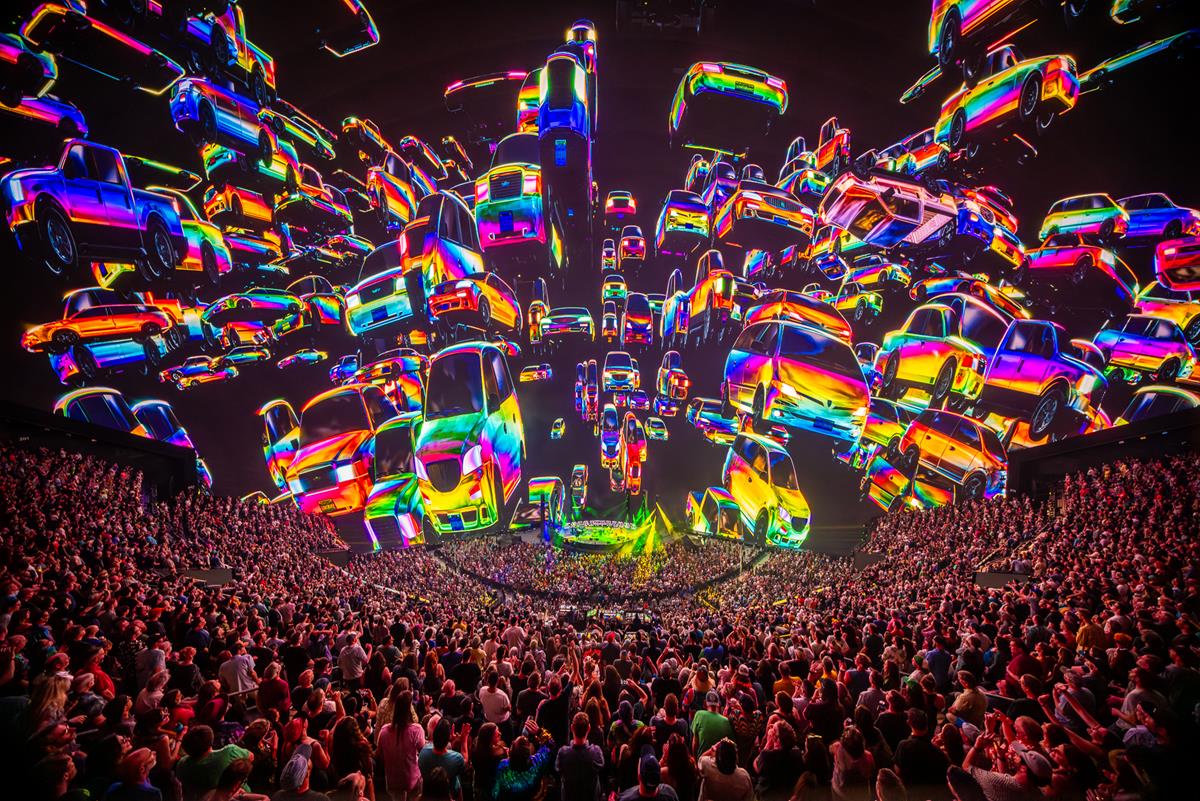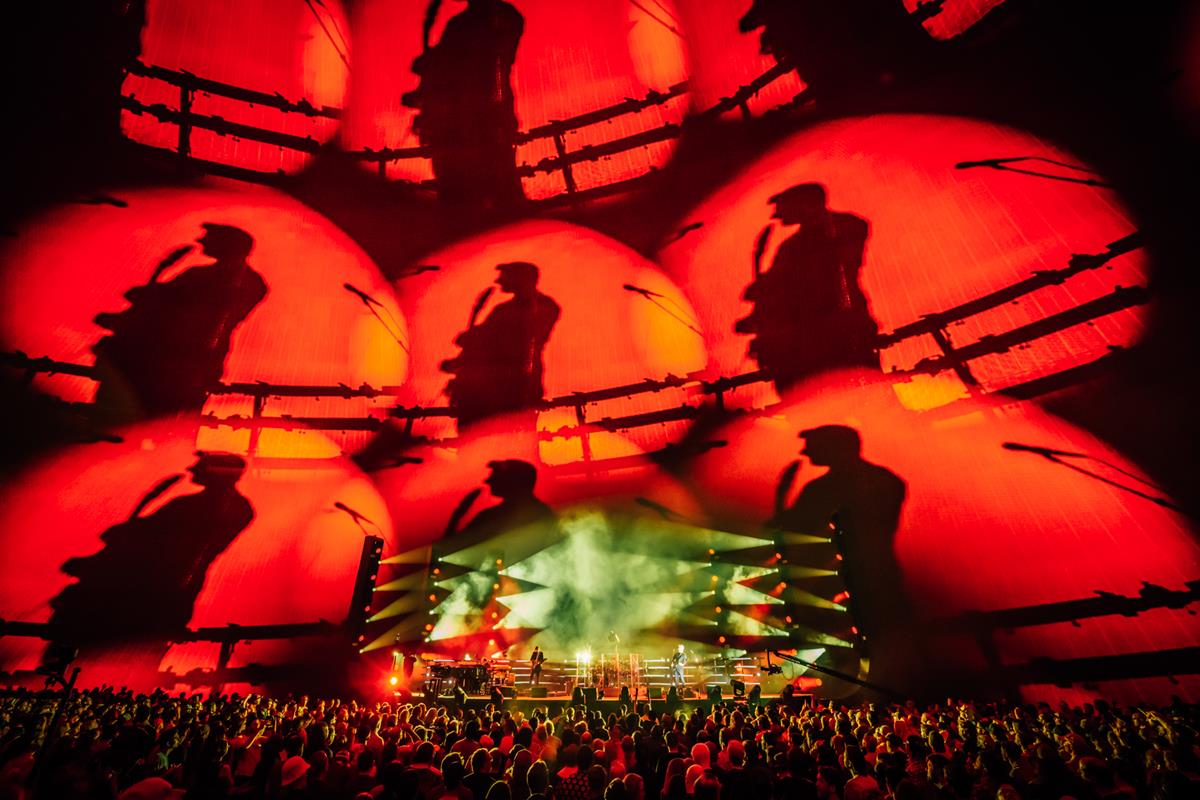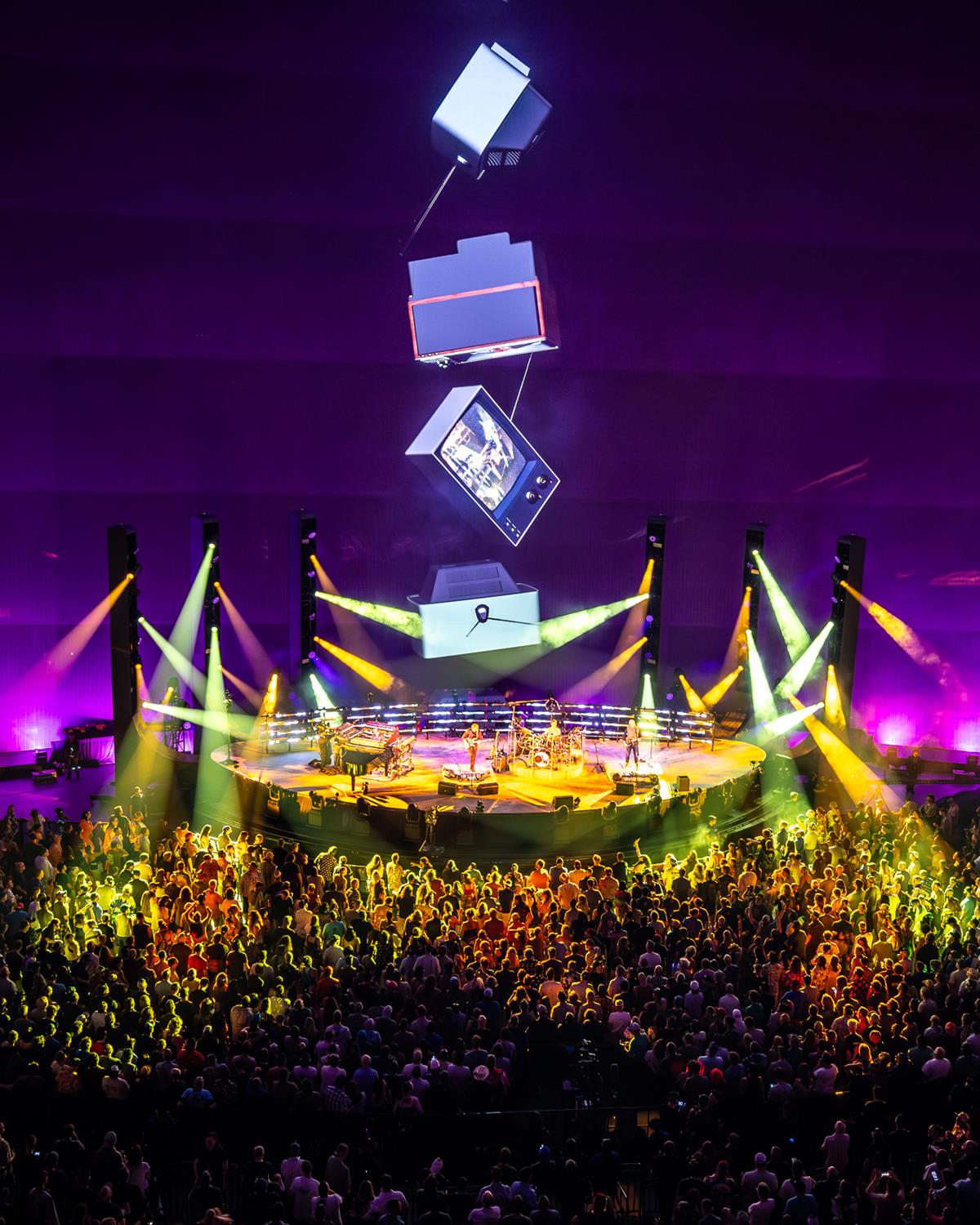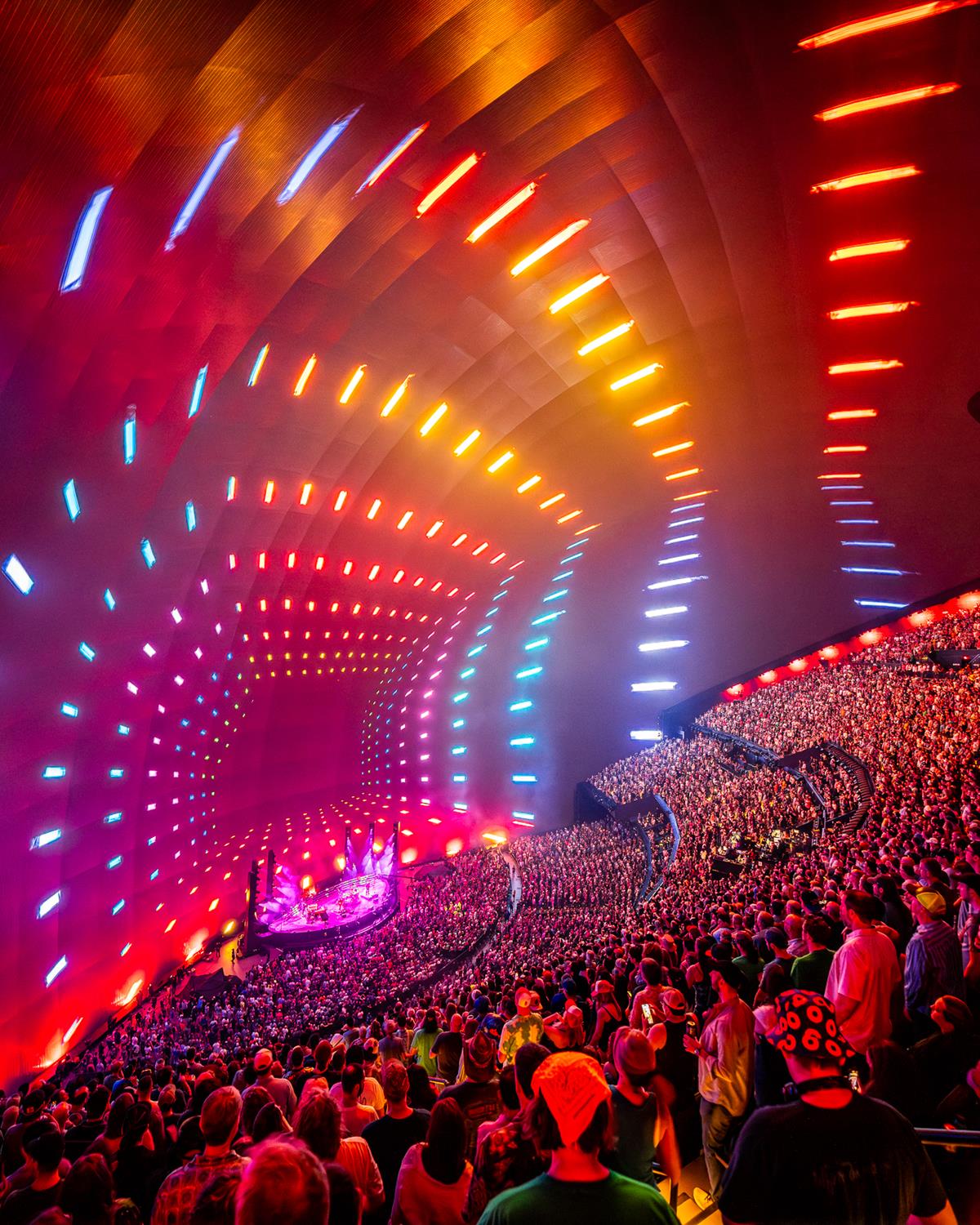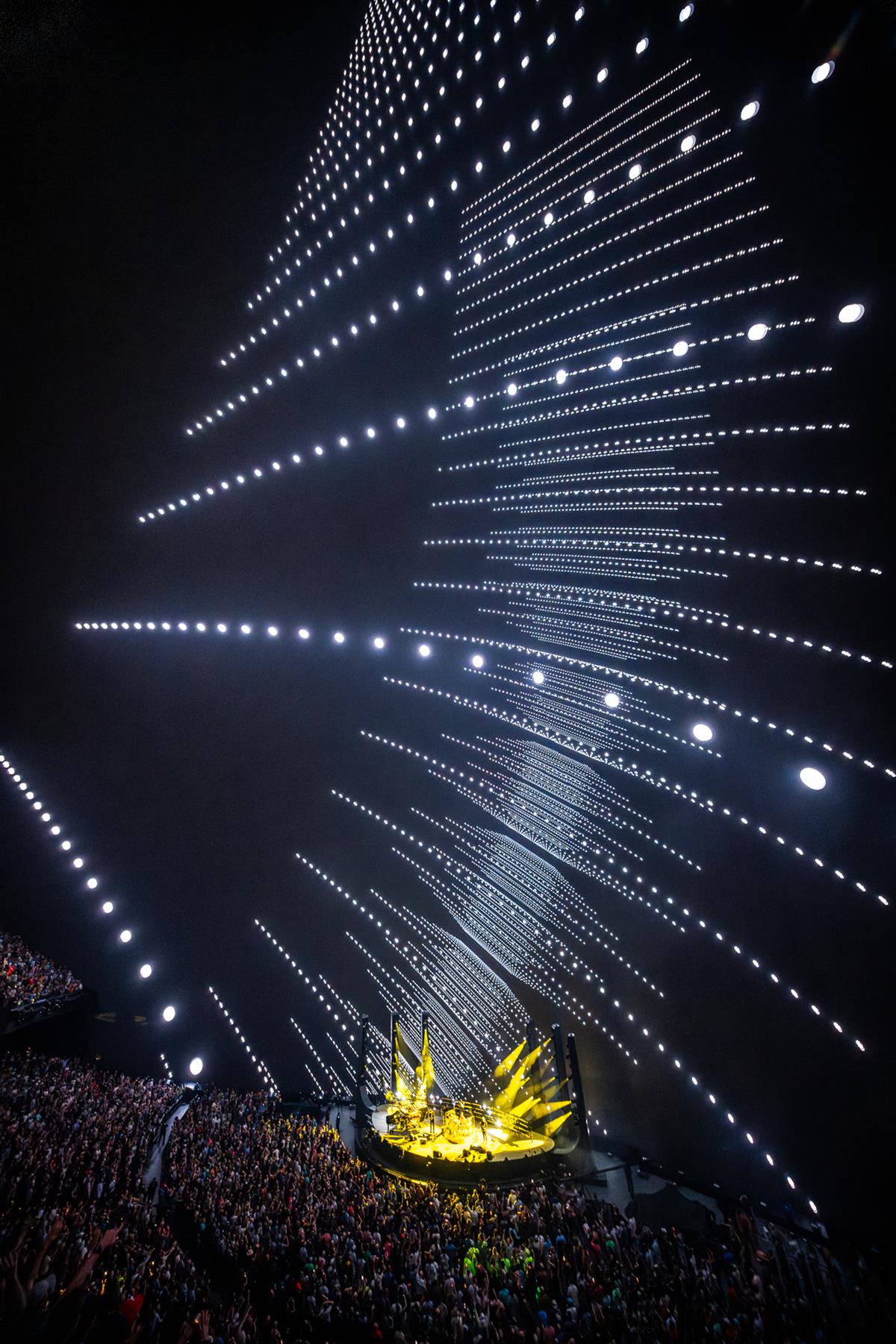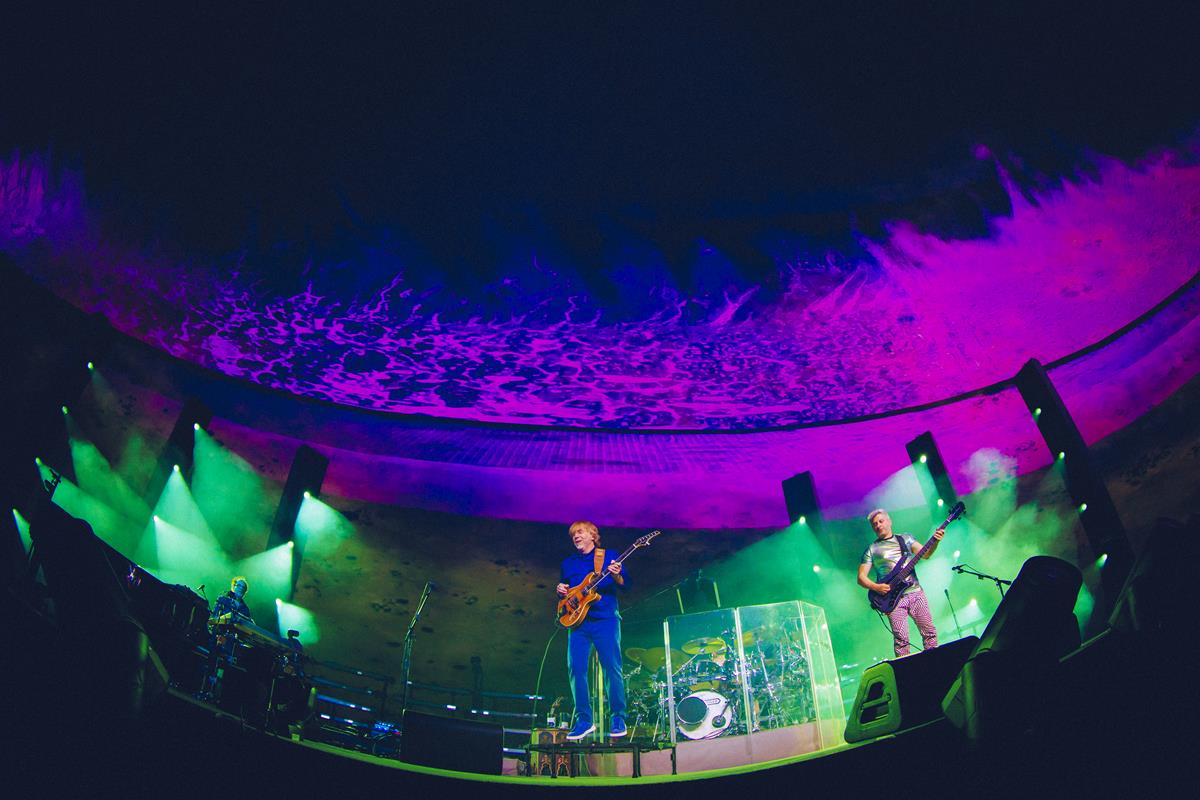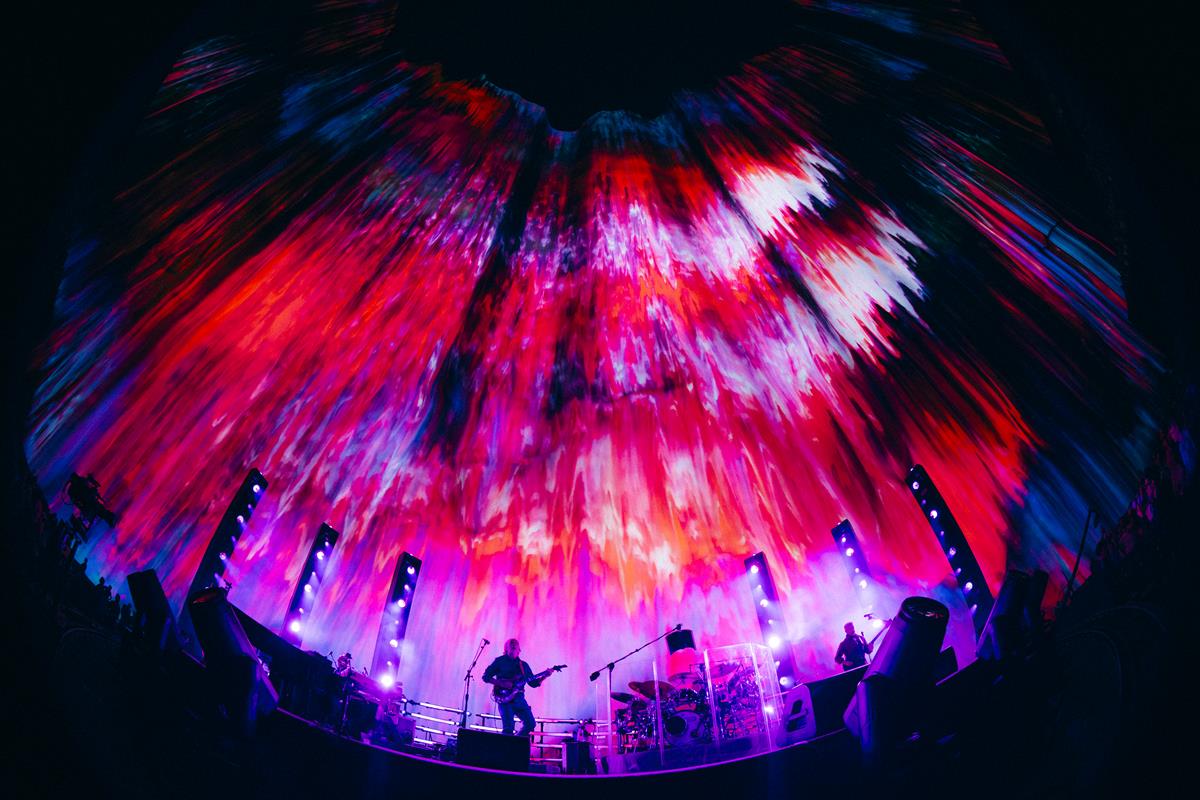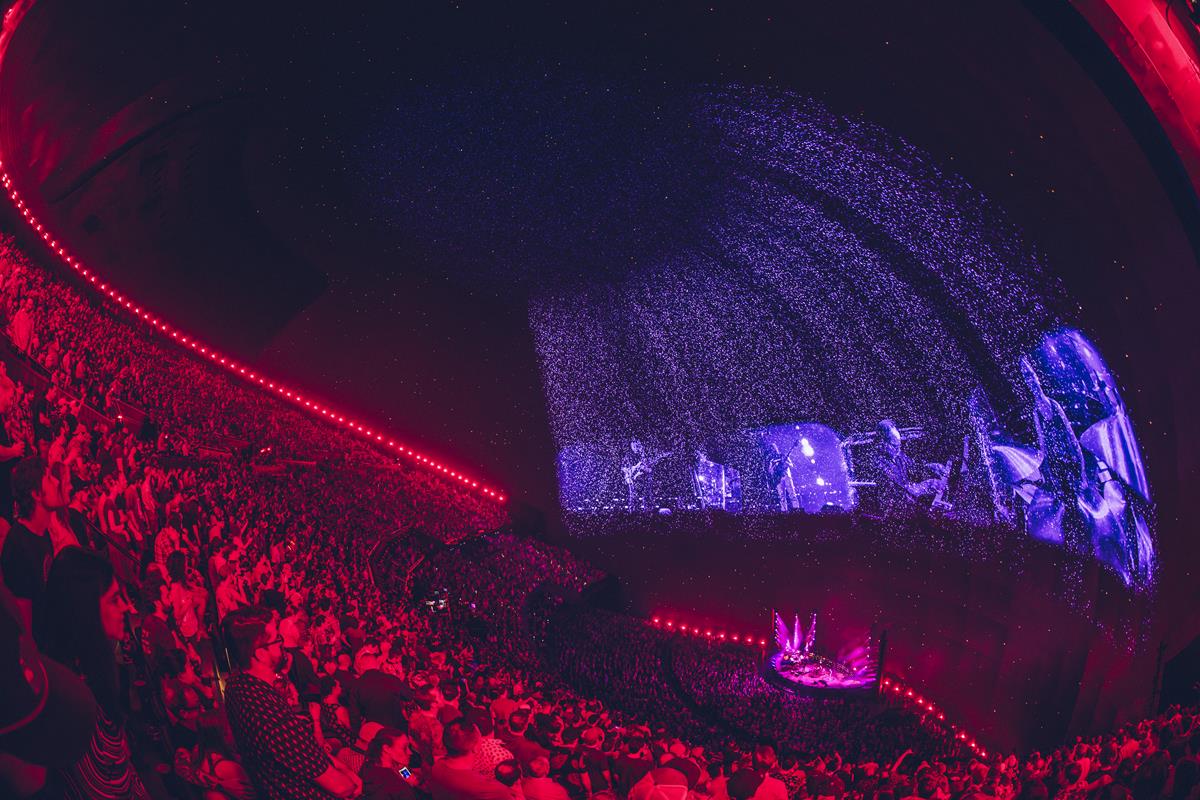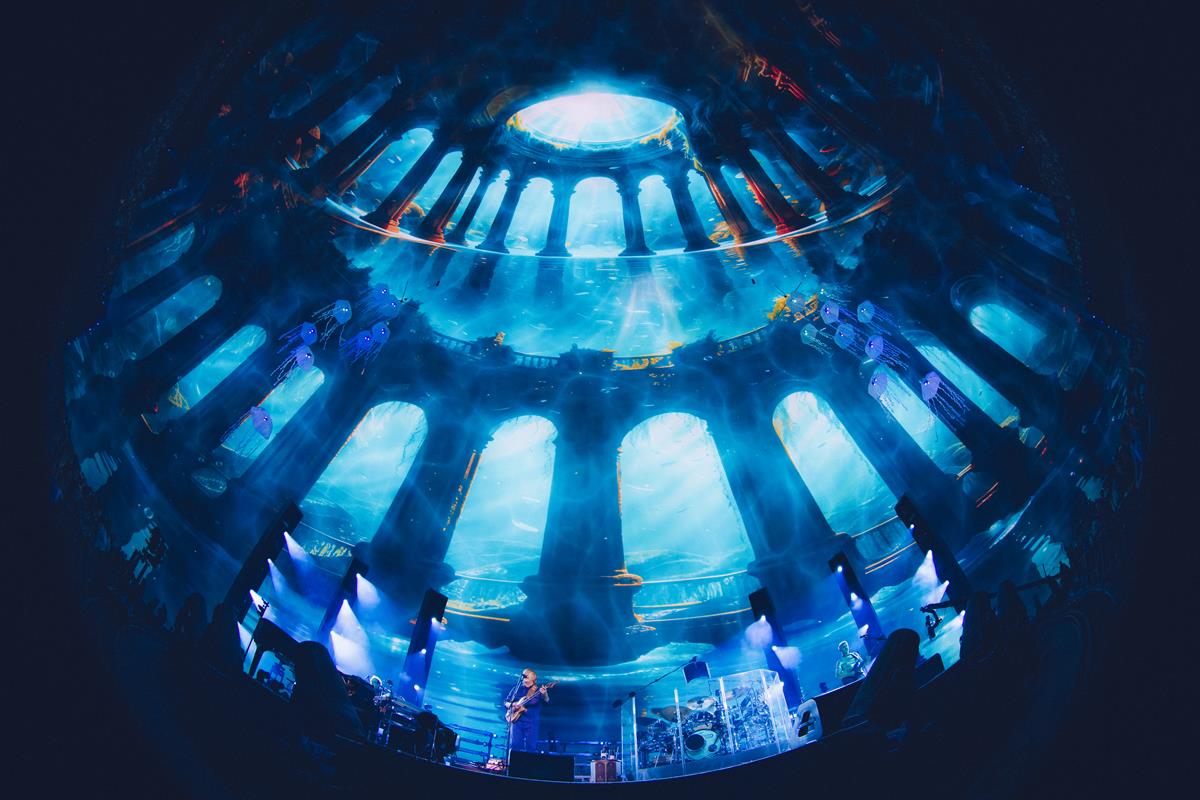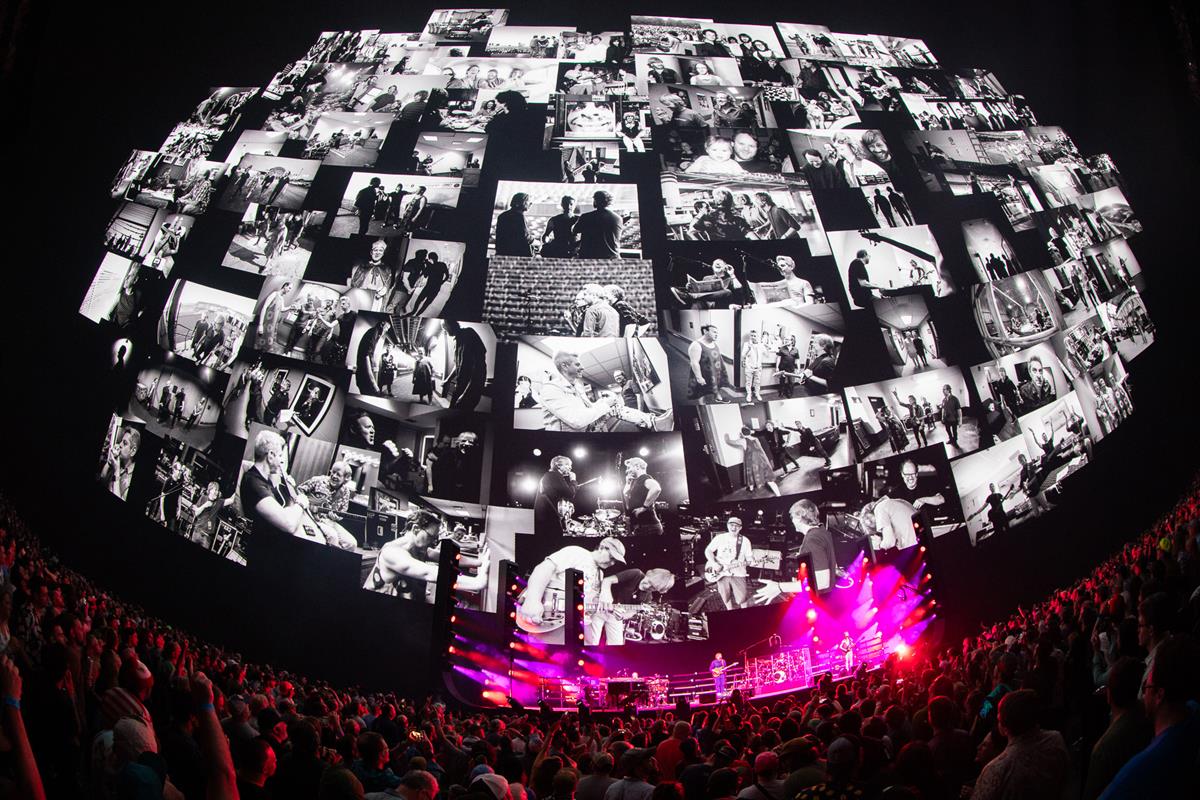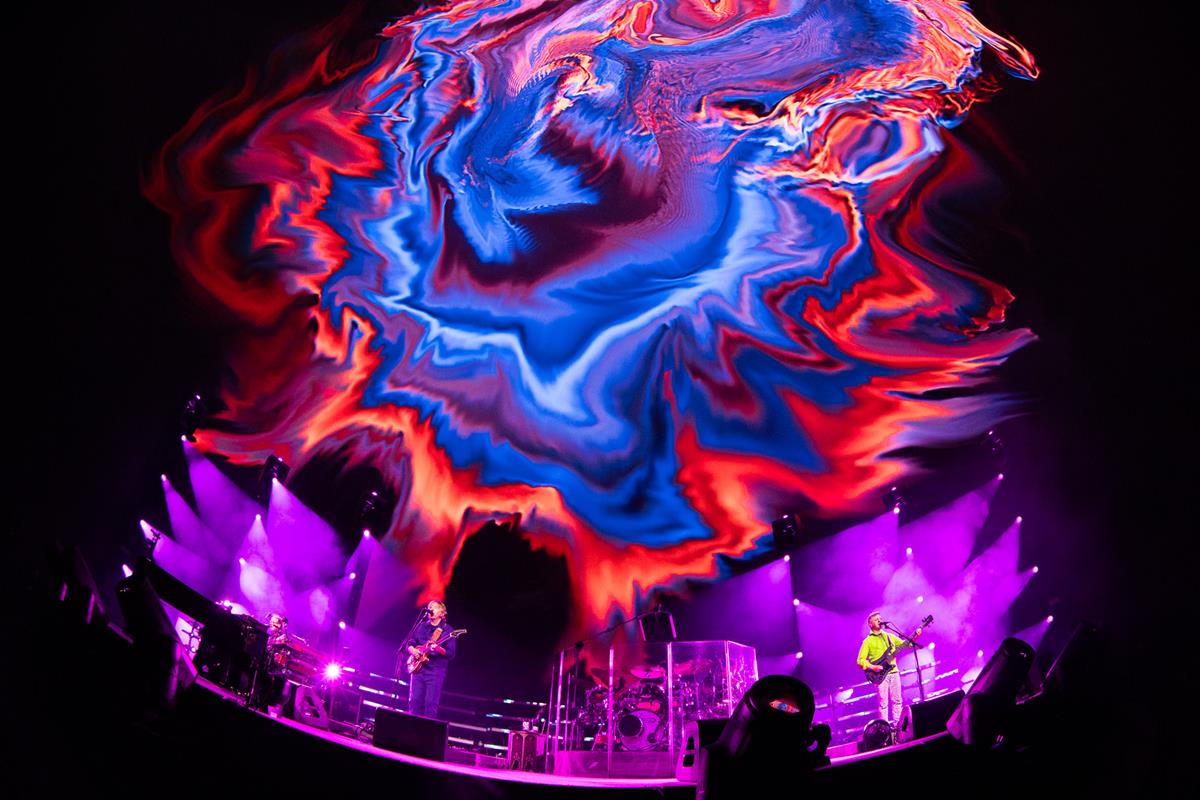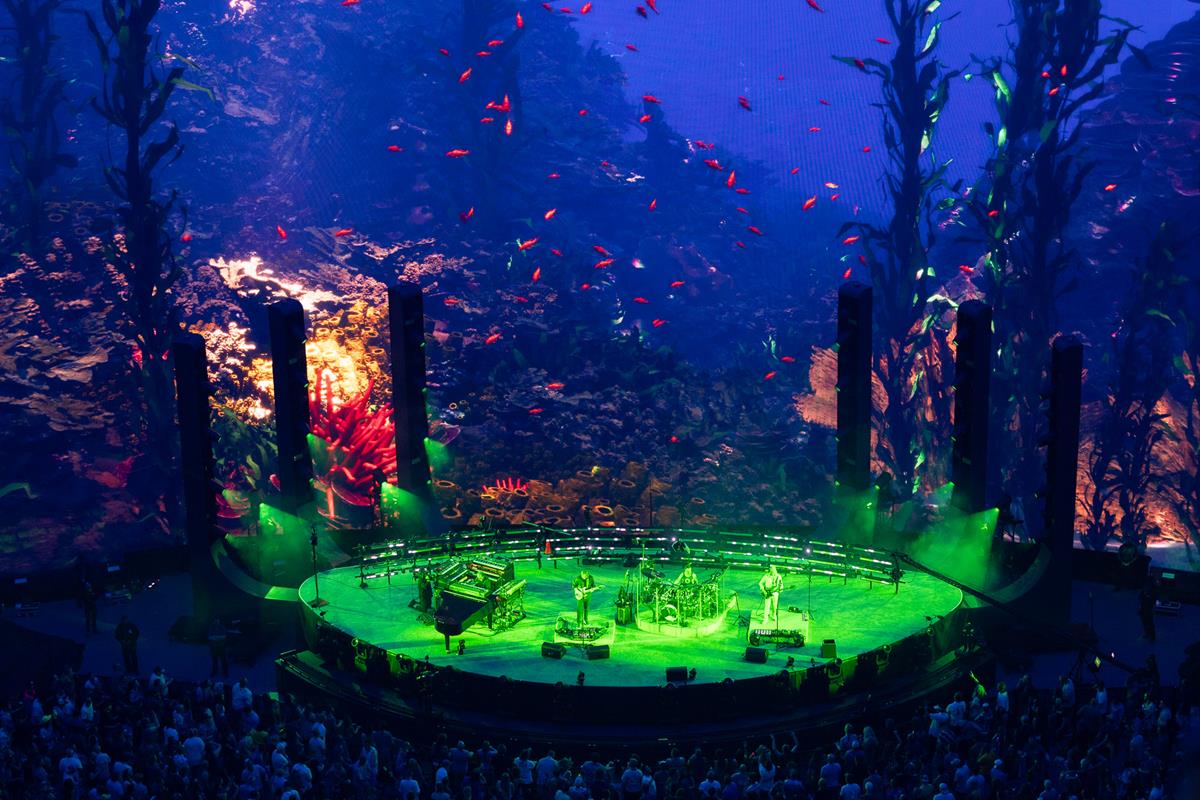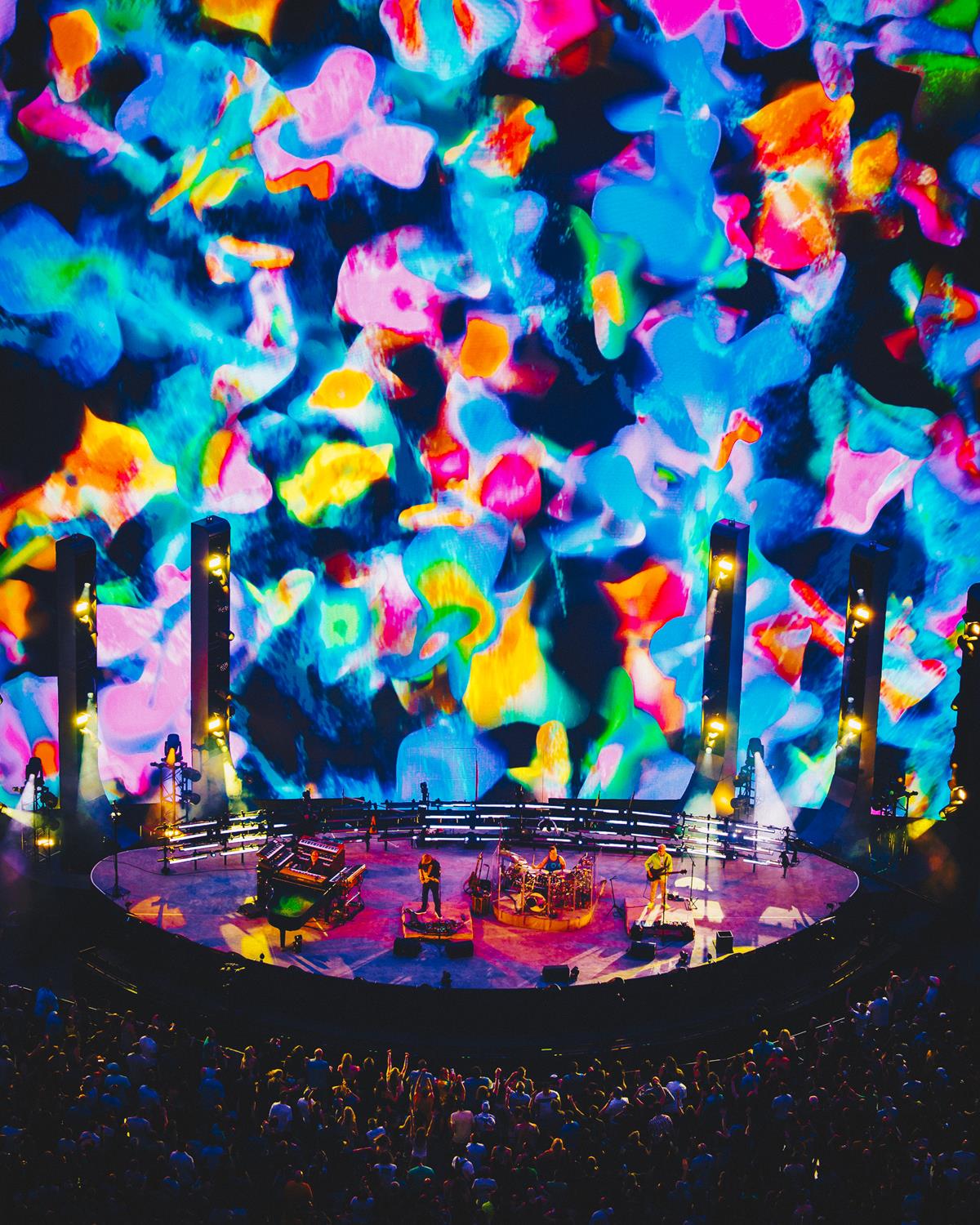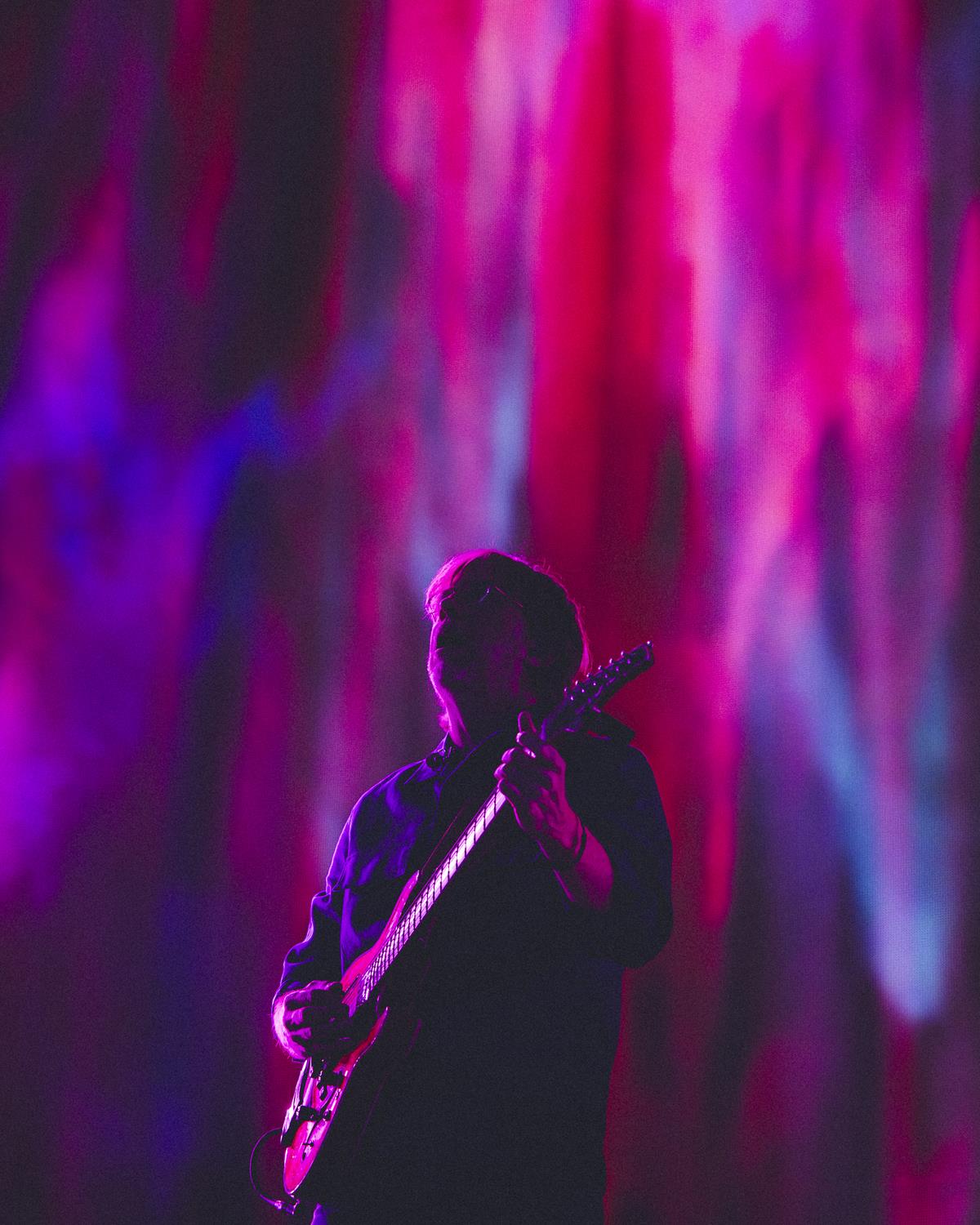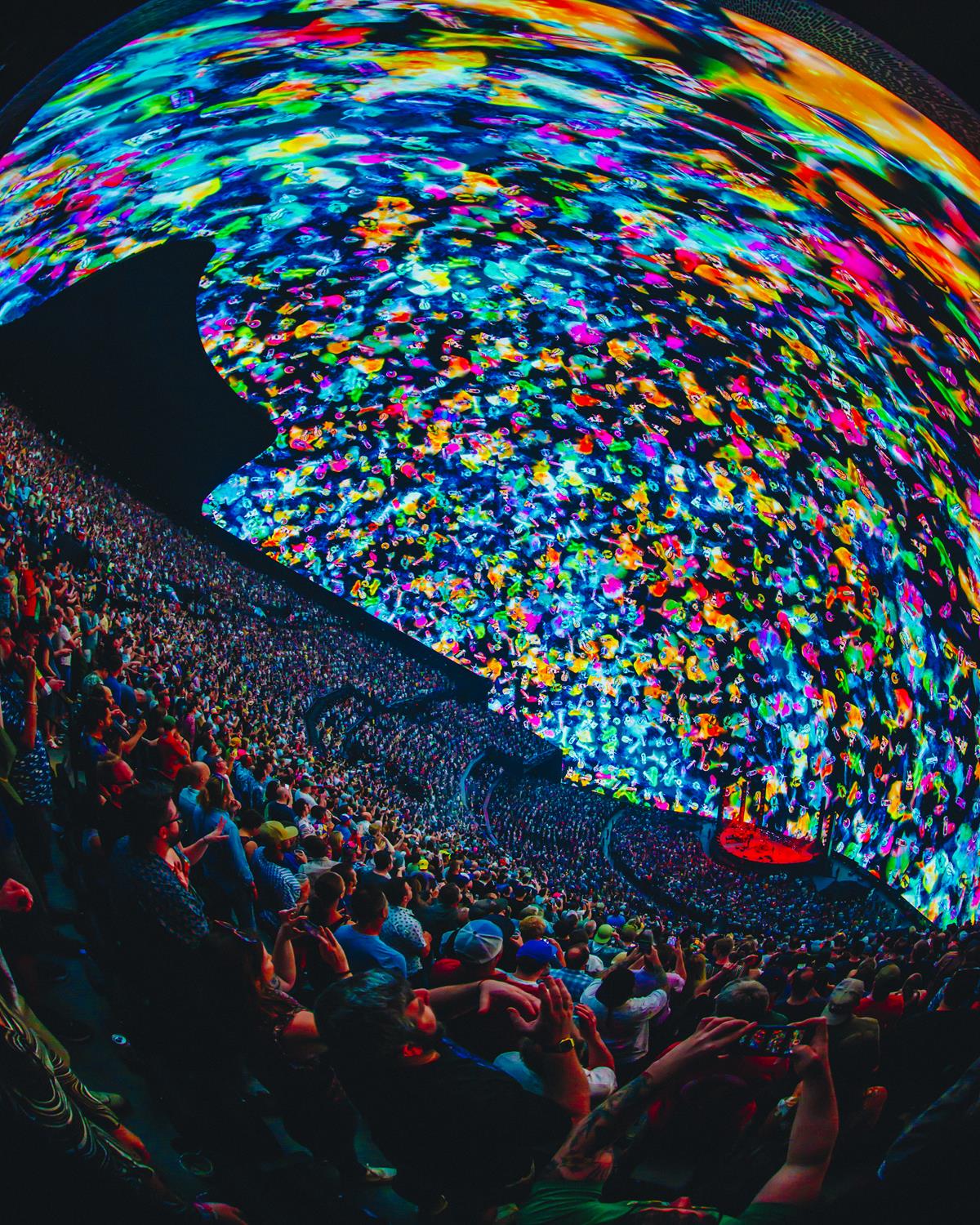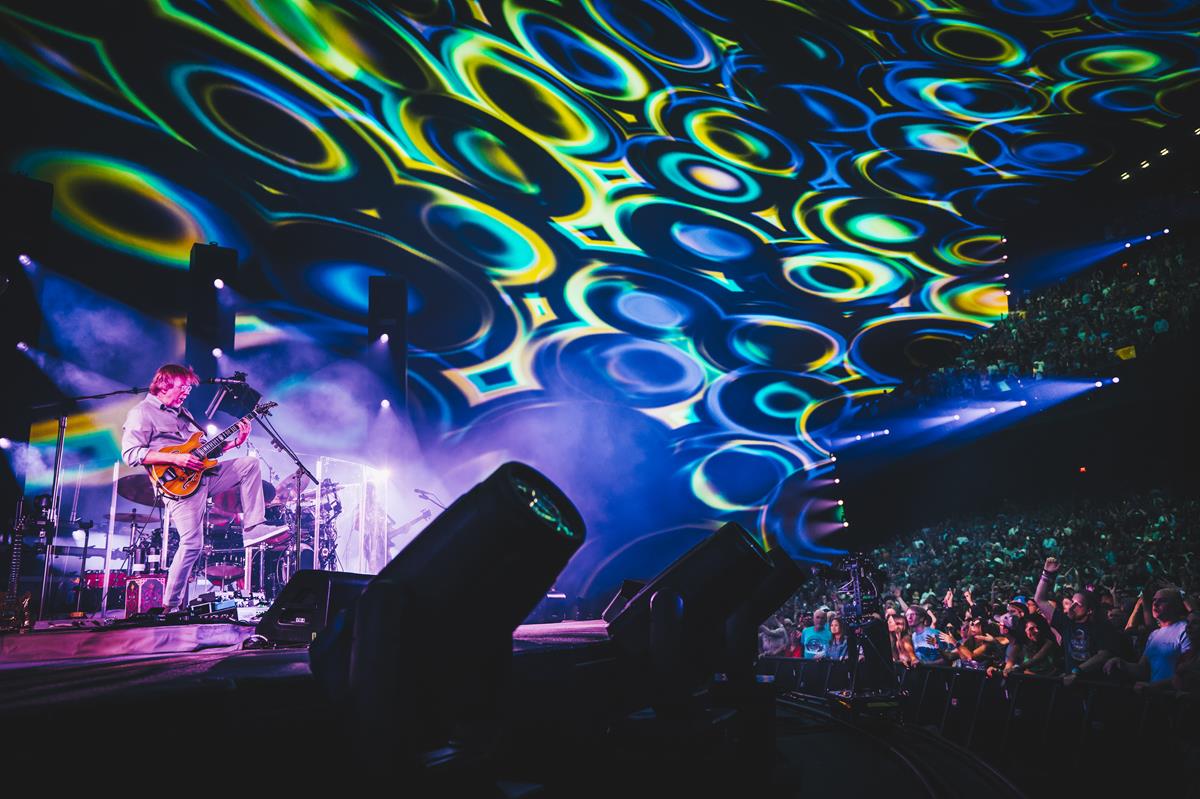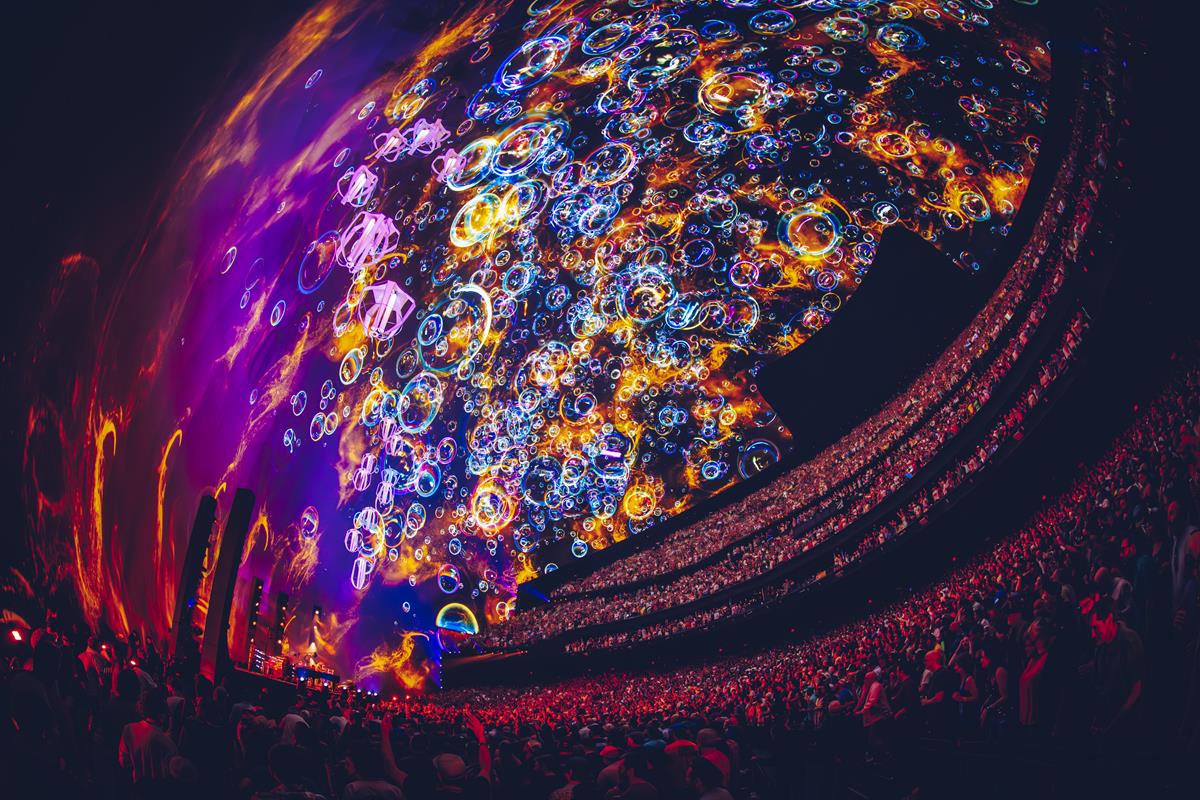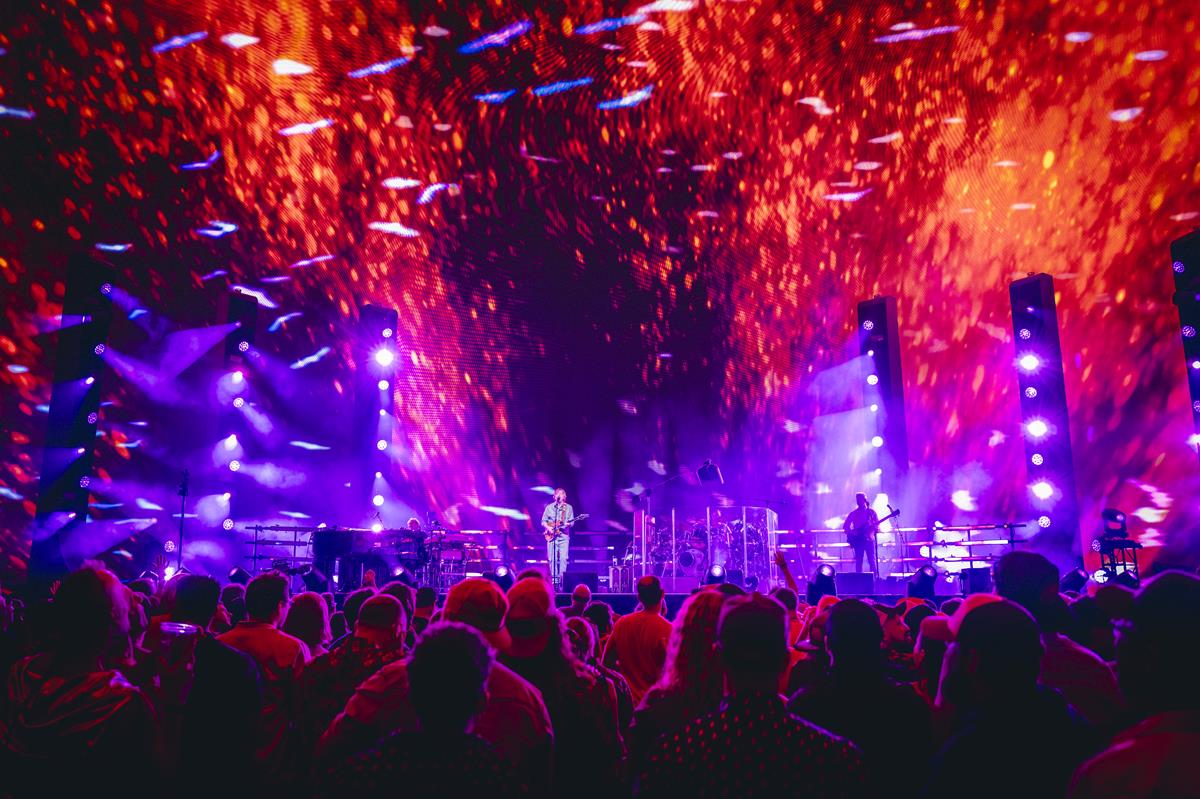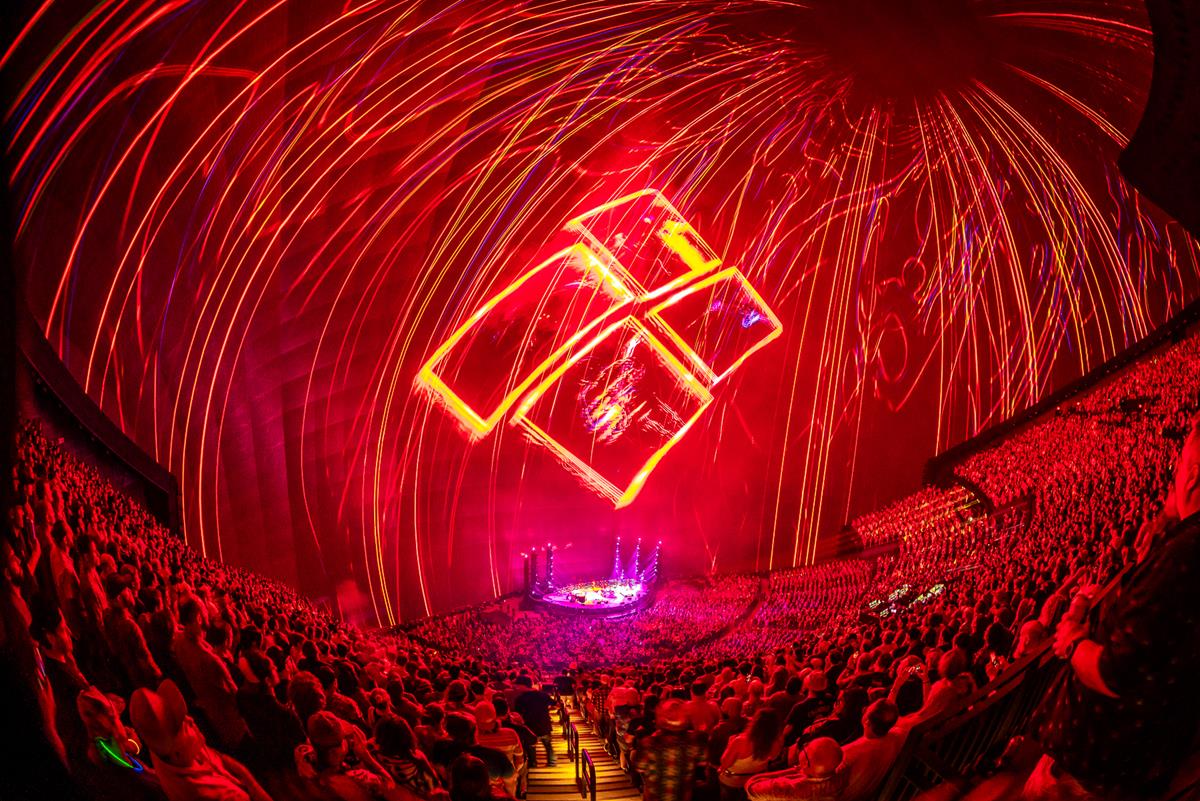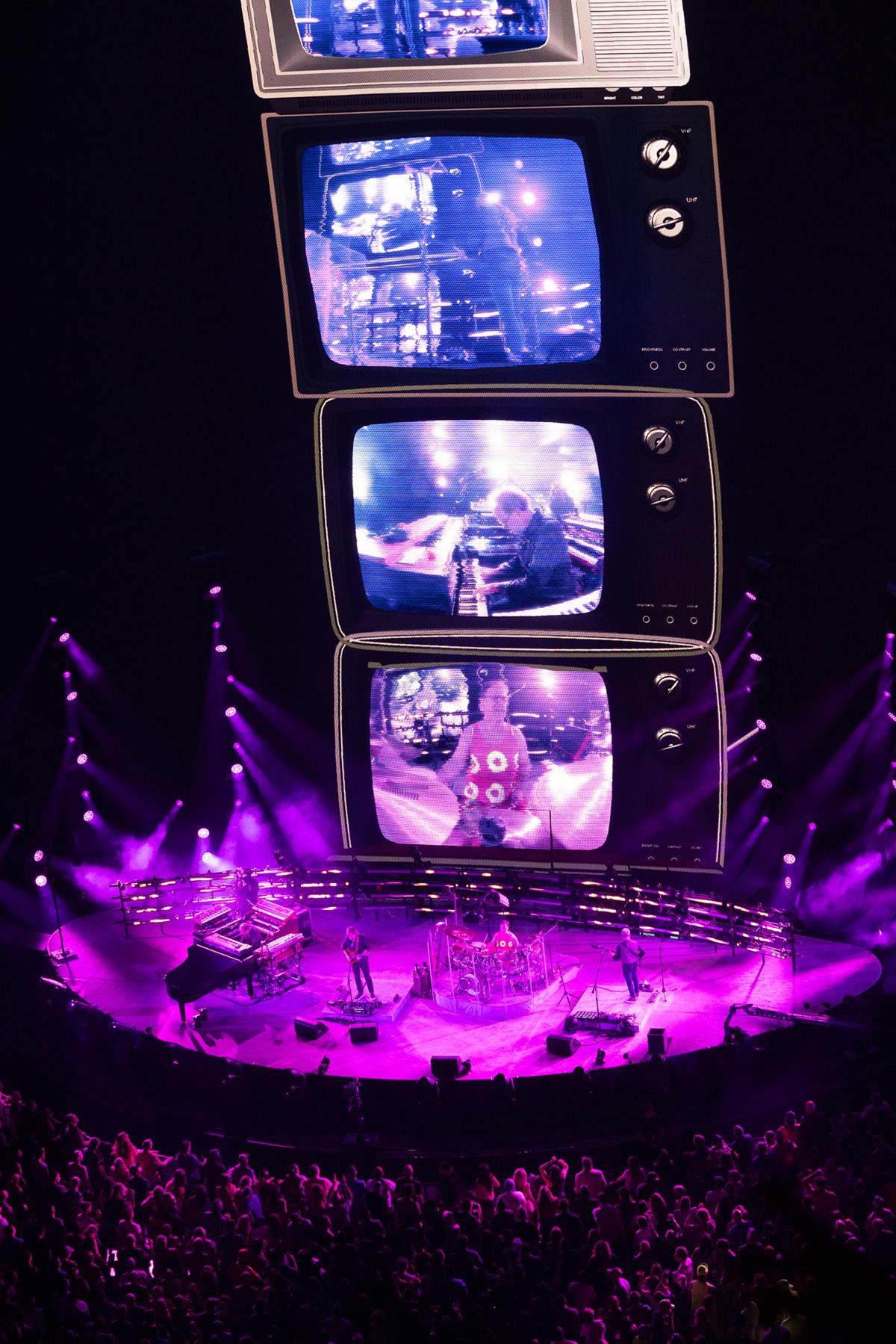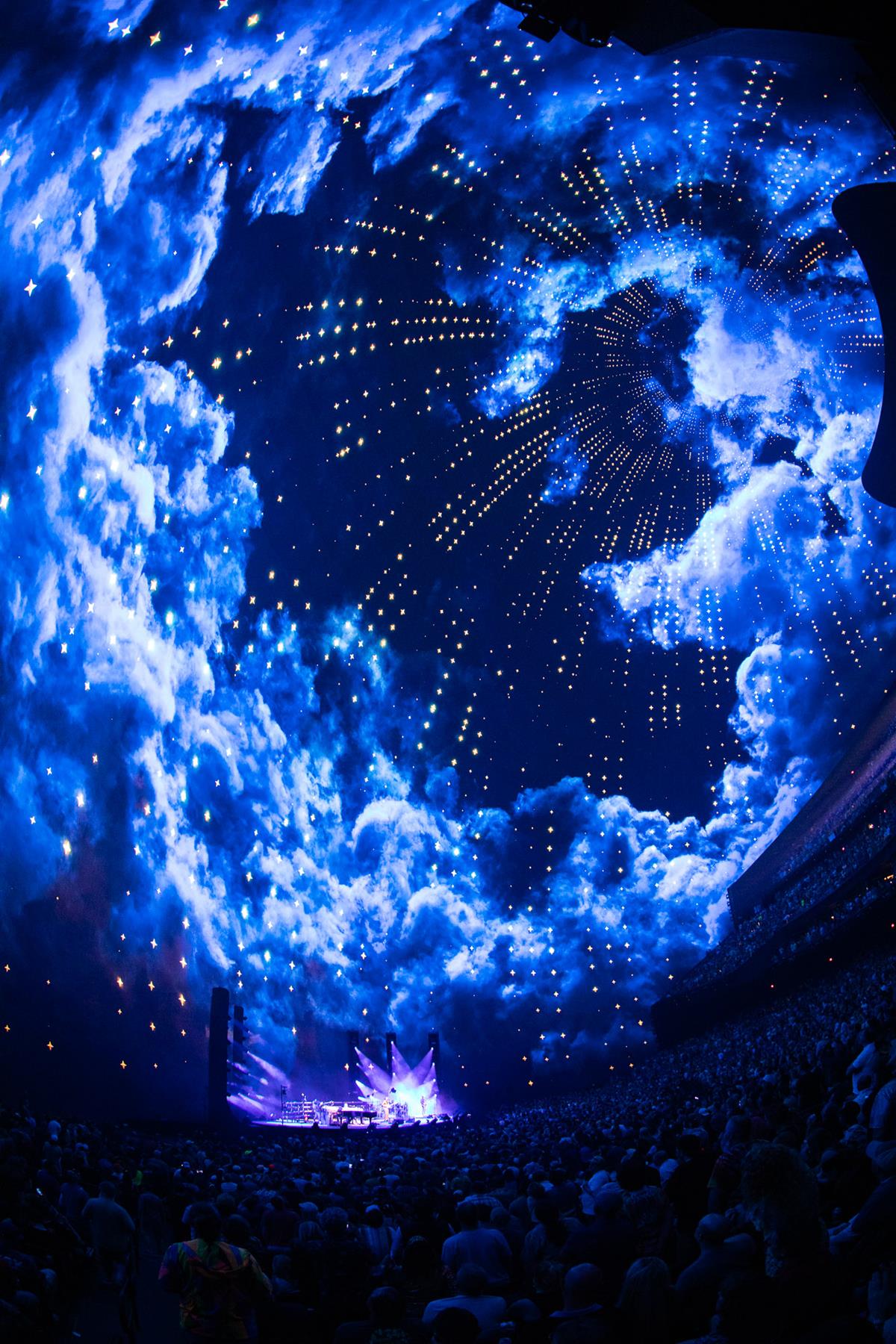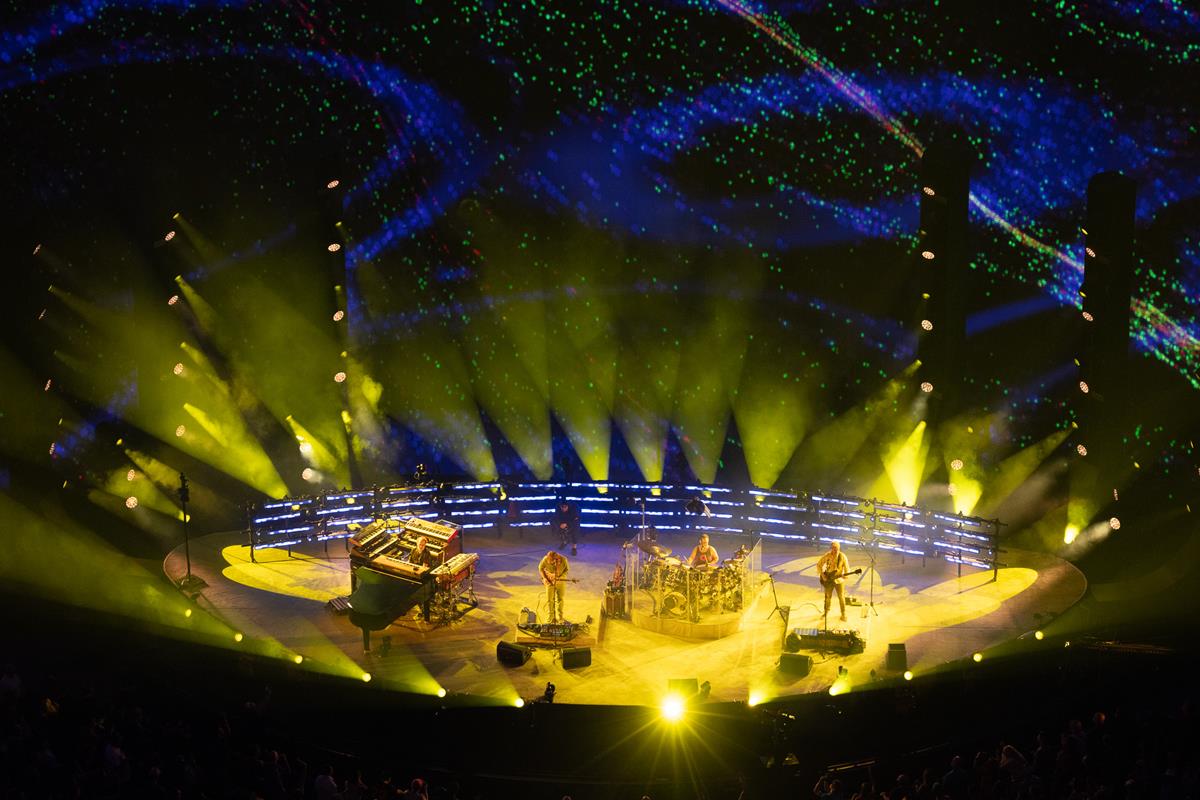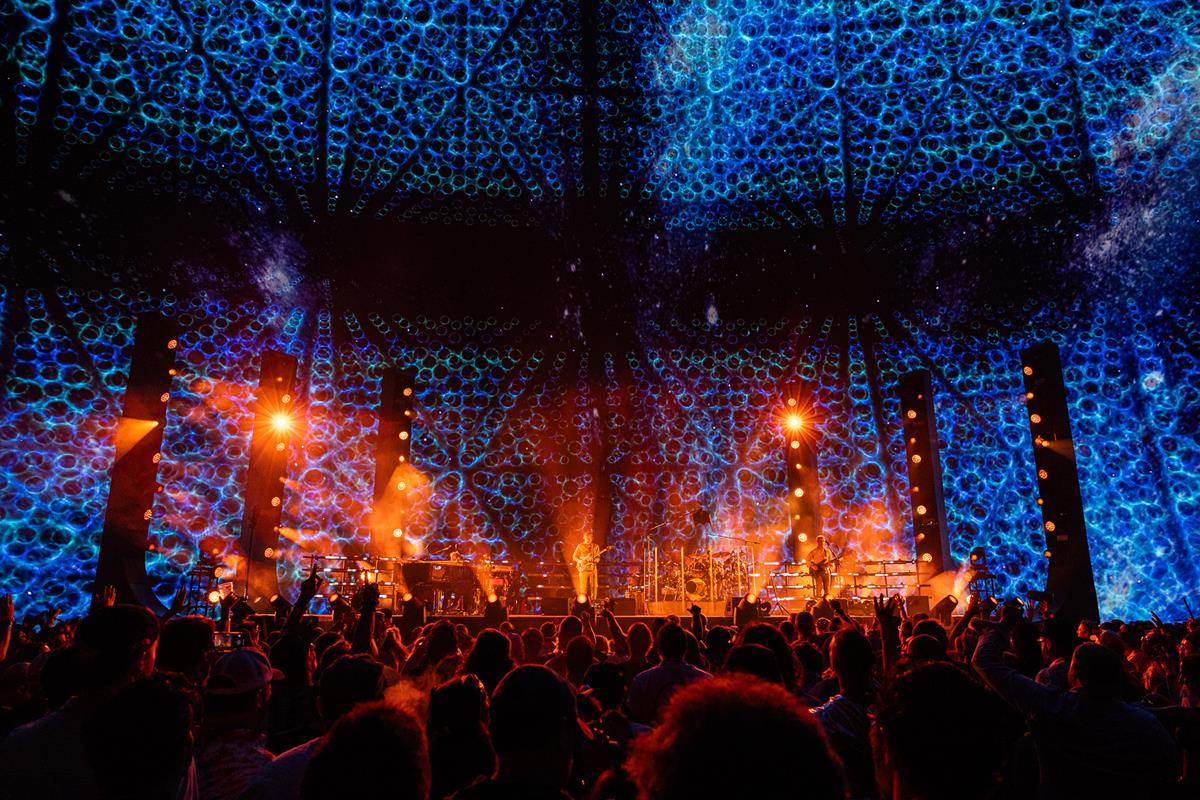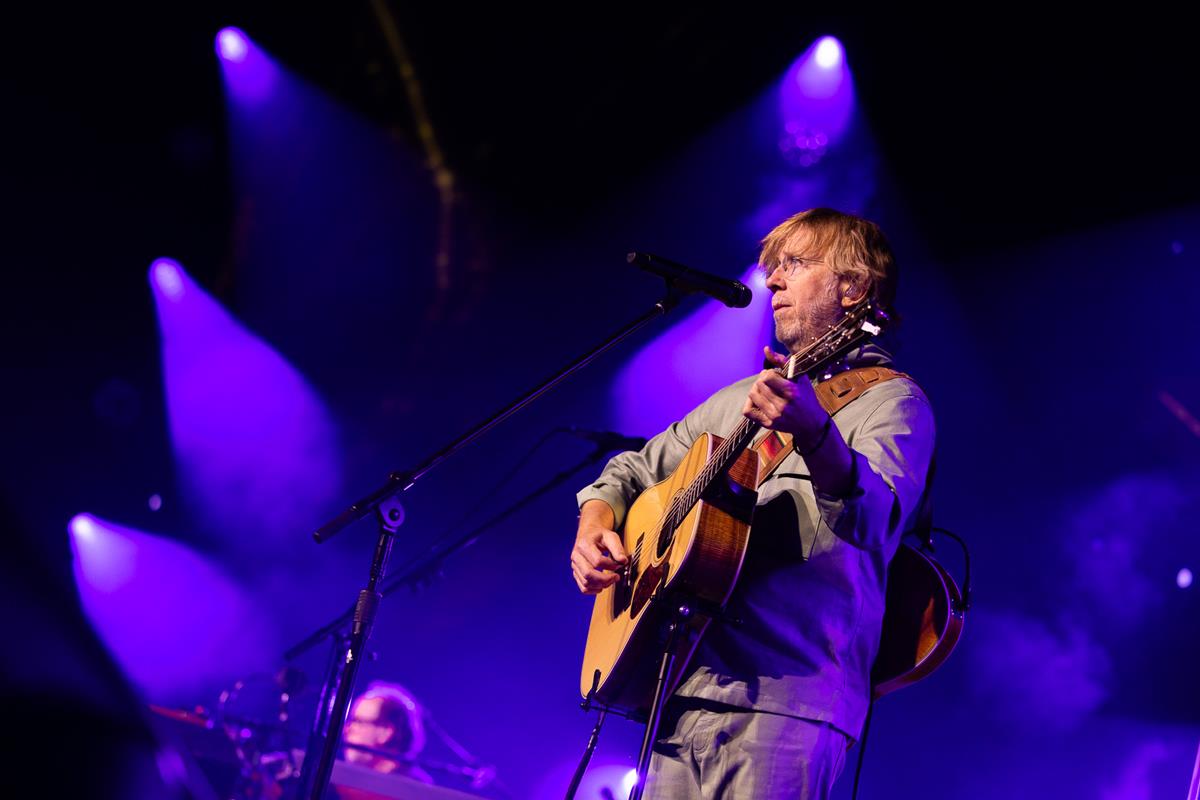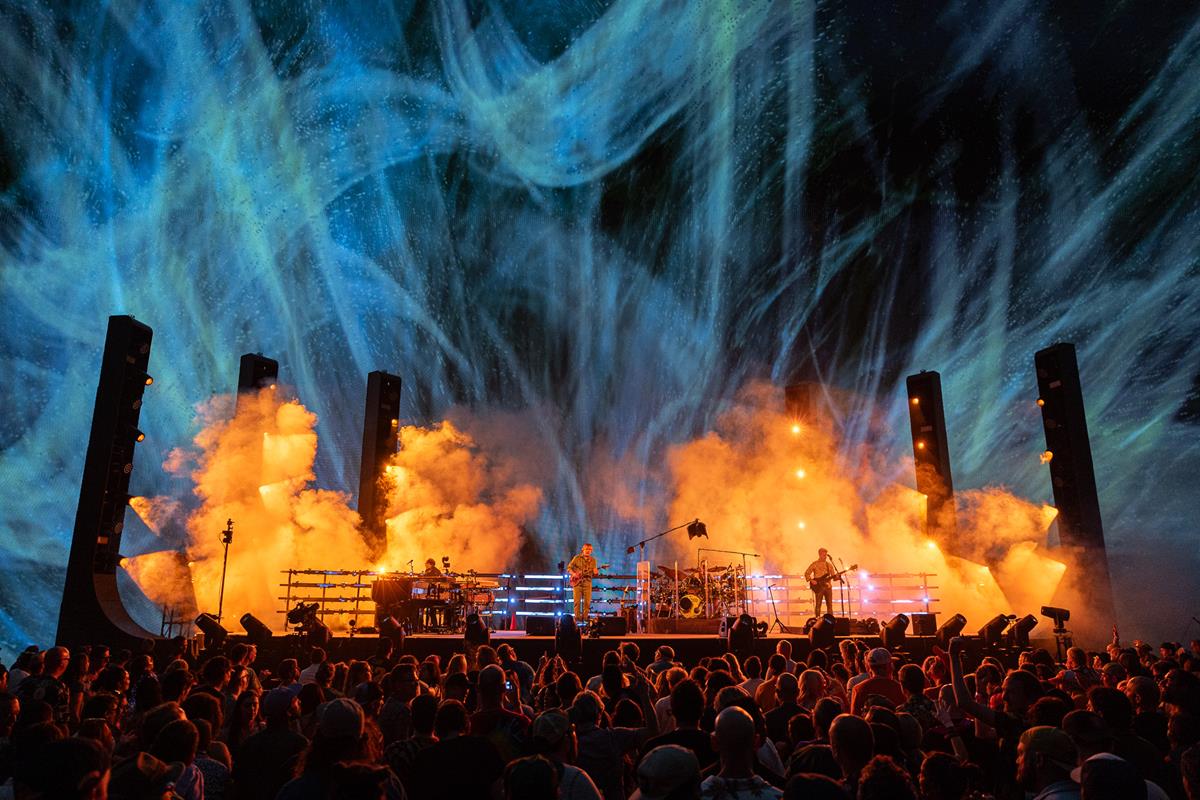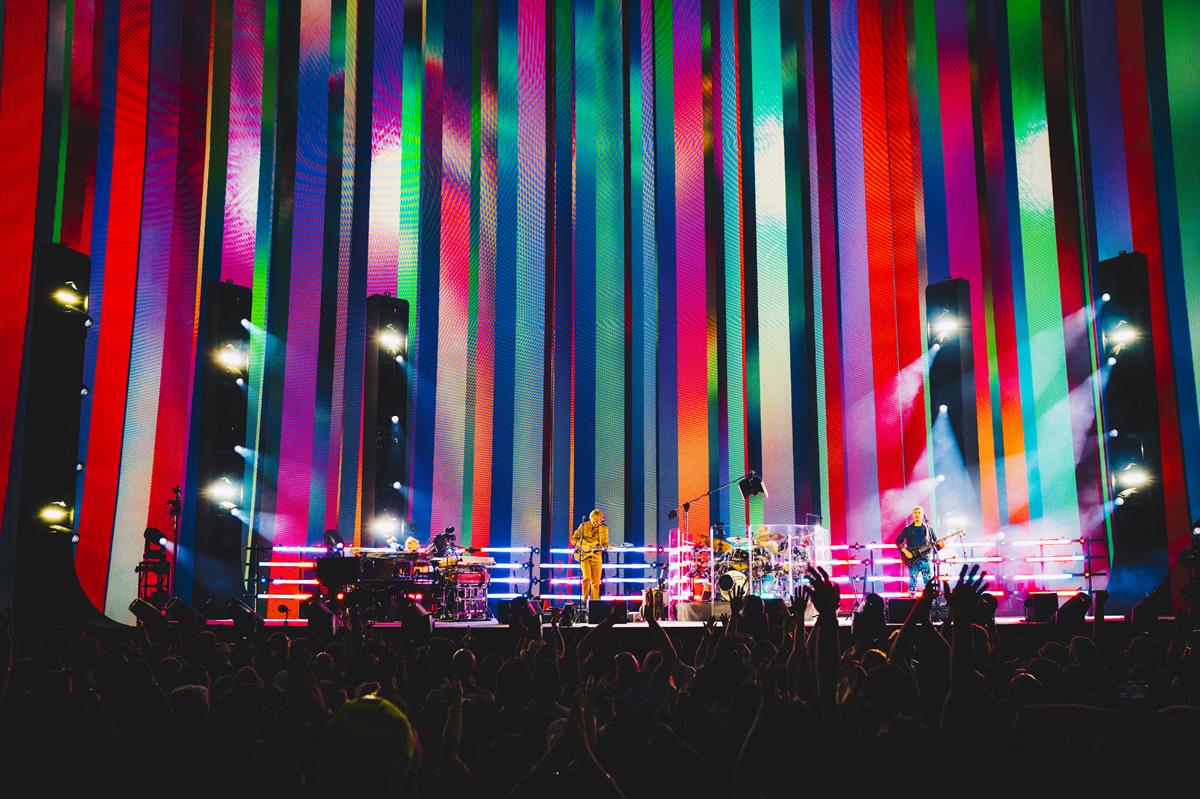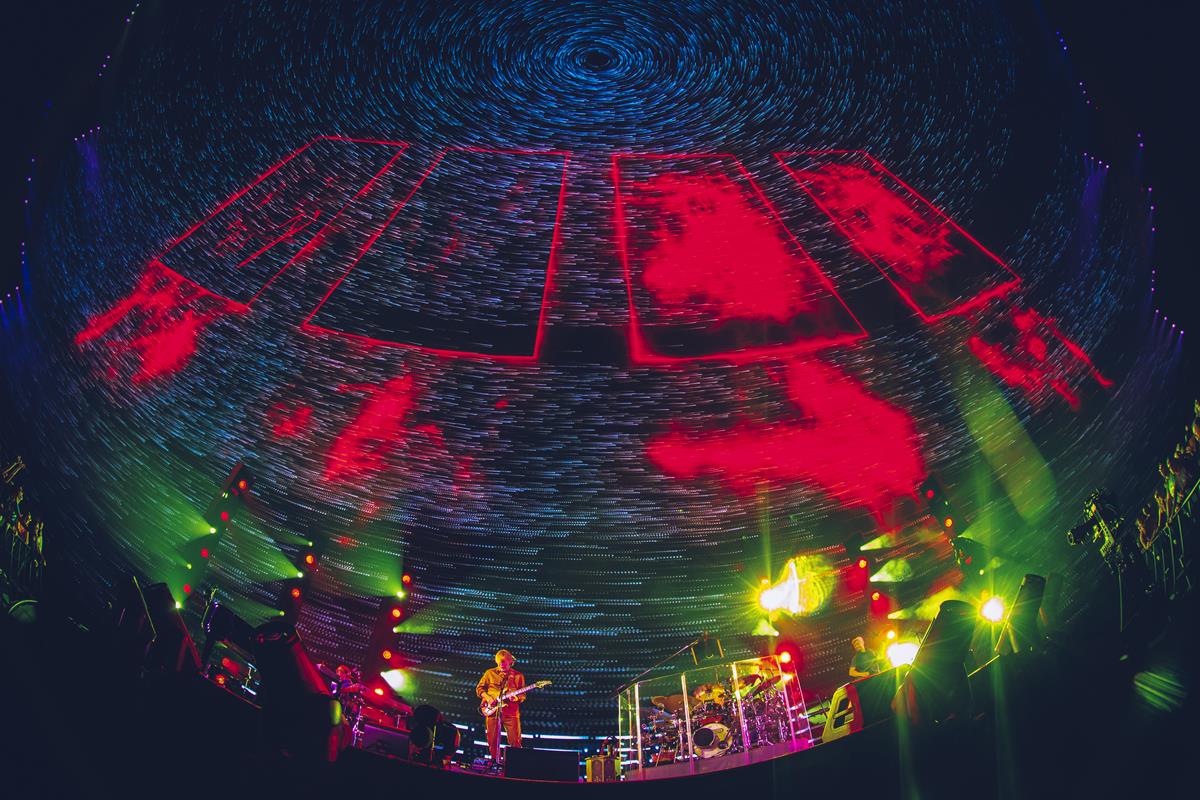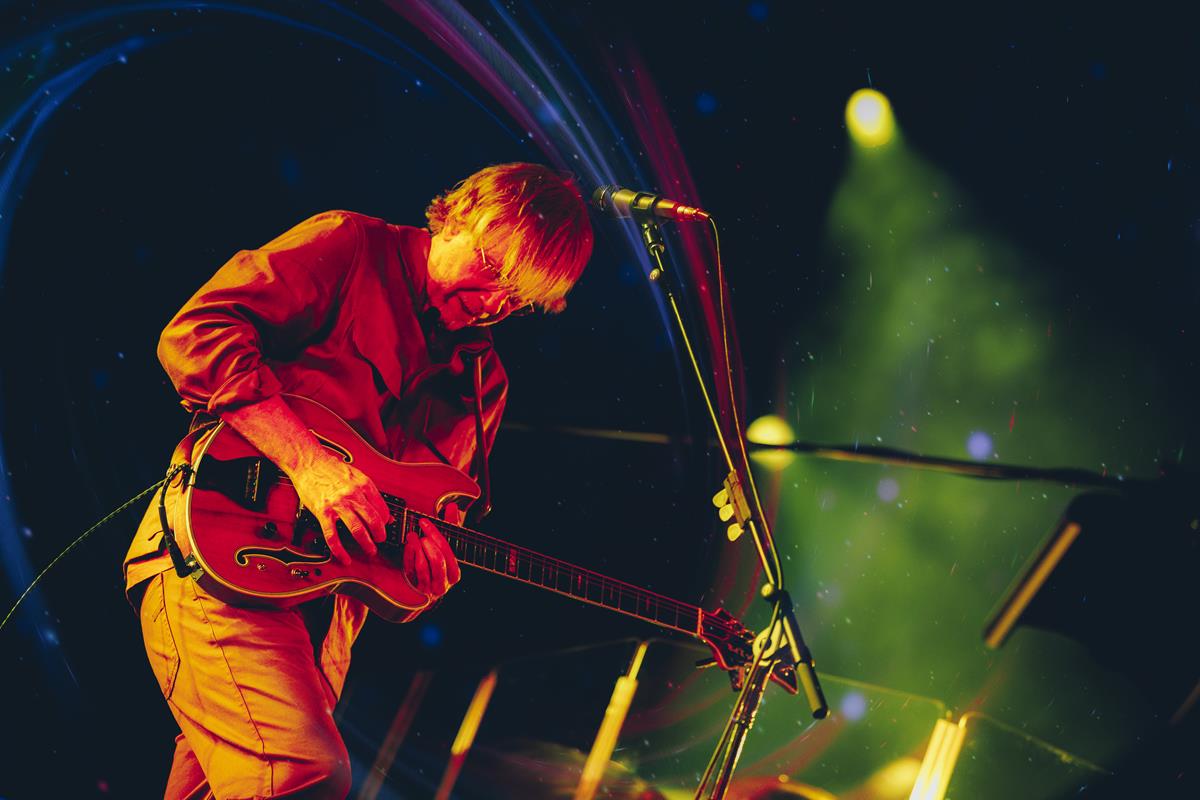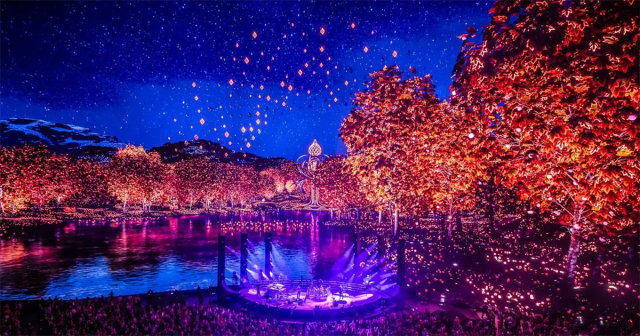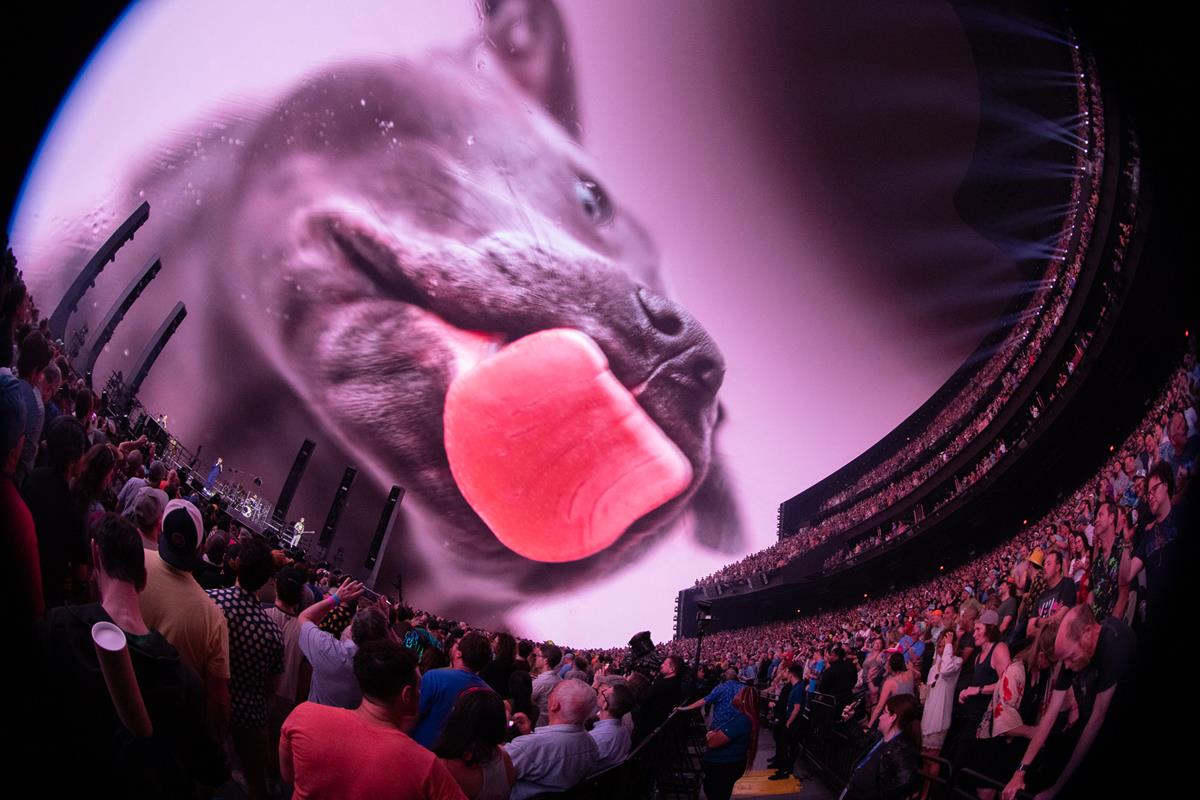
TL;DR
- Over four nights in April 2024, Phish transformed The Sphere in Las Vegas into a groundbreaking audiovisual experience, redefining live concert engagement and setting a new benchmark in the industry.
- Leveraging The Sphere’s advanced technologies, including a massive 16K by 16K LED screen and precise audio system, Phish delivered a unique blend of spontaneous music and immersive visuals that captivated both live and livestream audiences.
- Moment Factory collaborated closely with Phish to create a multimedia spectacle, using a mix of real-time and pre-rendered visuals that enhanced the band’s improvisational performance style.
- Jonathan Labbee from SACO Technologies discussed the technical challenges and innovations behind The Sphere’s visual systems, highlighting the integration of extensive LED displays that contributed to the venue’s dynamic visual impact.
Phish performing “Carini” at Sphere
Amid the neon glow and perpetual buzz at the heart of Las Vegas, the Phish concerts at The Sphere mark a seminal moment in the evolution of live music experiences. Described by Charlie Warzel at The Atlantic as “a glorious, $2.3 billion arena,” The Sphere set the stage for an unprecedented exploration of sensory immersion and musical innovation. Over four nights in April, Phish leveraged this state-of-the-art venue to transcend traditional concert boundaries and redefine audience engagement.
Phish’s approach contrasted sharply with the prior residency by U2, as Warzel recounts. Where U2’s shows were a polished spectacle, he writes, Phish’s performances were a vibrant testament to their improvisational roots and eclectic flair.
The Verge’s Chris Welch had a similar response: “U2’s 40-show Sphere run was a polished, extravagant rock show with (nearly) identical set lists the whole way through. The Sphere was a perfect canvas for making rock stars like Bono and The Edge appear not just larger than life but supersized,” he noted ahead of the shows. “By contrast, Phish is only doing four performances and has no plans of repeating even a single song.”
This approach more than paid off, Welch said, even for livestream audiences. “Fans in attendance seemed enamored by the experience, and those livestreaming from home praised night one as among the best-sounding Phish shows they’ve ever heard — even if they didn’t get to live through all the immersion firsthand.”
READ MORE: How Phish turned Las Vegas’ Sphere into the ultimate music visualizer (The Verge)
Phish performing “Everything’s Right” at Sphere
Spectacular Immersion Boosted by a “Pinpoint-Accurate” Sound System
Livestream viewers may have been pleasantly surprised by the high-quality experience they received, but in-person audiences were completely blown away.
READ MORE: Drew Carey Can’t, Won’t Stop Gushing About Phish Show at Sphere, Saying Previous Resident Felt Like ‘Bar Band’ By Comparison (Billboard)
Abigail Rosen Holmes, director & co-creative director for Phish’s Sphere shows, told Josh Cornfield at AP News, “We came in really wanting to do a show that was a great Phish show.” She said the band and its creative team wanted to mix the Sphere’s technical capabilities and consider “what can we do for Phish that we maybe couldn’t do for any other artist?”
Phish employed custom visuals on The Sphere’s massive 160,000-square foot 16K-by-16K LED screen, overseen by Holmes and lighting guru and longtime Phish collaborator Chris Kuroda. Supplemented by 300 mobile speaker modules, The Sphere features 1,600 permanent speakers that use a 3D audio beamforming and wave field synthesis technology to spread sound throughout the venue.
The venue offers 17,500 seats, in addition to a standing floor space that accommodates roughly 2,500 people. “The seats use haptic technology,” says Cornfield, “so every bass line and drum kick from the band can be felt from your chair — for those actually sitting and not standing up and dancing.”
READ MORE: Here’s how Phish is using the Sphere’s technology to give fans something completely different (AP News)
The Sphere’s technology, including its “pinpoint-accurate” sound system, played a crucial role in delivering not just spectacle, but community, for die-hard Phish-heads and newcomers alike. As Los Angeles Times reviewer Mikael Wood noted, at one moment the venue transformed into a starry night sky so vivid that “you could almost believe the roof had retracted.” This technological marvel enabled Phish to produce a show that was not about “excess or grandiosity,” he said, but rather an intimate, “homey, friendly, deeply quirky” experience.
READ MORE: Review: Phish’s Las Vegas Sphere spectacle was the opposite of rock-star self-glorification (Los Angeles Times)
The venue’s sound system, which includes spatial-audio technology that allows individual sounds to be projected to pinpointed locations in the room from any direction, was a crucial part of the communal experience, Warzel said. “Although Phish was doing a commendable job dazzling our rods and cones with a 366-foot spectacle that the Sphere alone can deliver, they had cracked the code on something much more important: the venue’s sound system, which is equipped with wave-field-synthesis spatial-audio technology.”
The impact of these concerts on the attendees and the broader music community has been profound. As one concert-goer reflected to Warzel, “This was like the first time again,” capturing the fresh and transformative impact of the performance. Phish and The Sphere offered a glimpse into the future of immersive entertainment — a blend of cutting-edge technology with spontaneous and vibrant live performances that promise to captivate and engage audiences in new and exciting ways.
READ MORE: Sphere Is the Mind-Killer (The Atlantic)
Immersive Real-Time Graphics from Moment Factory
Montreal-based multimedia entertainment studio Moment Factory collaborated closely with Phish to transform Sphere into a vessel of unparalleled audiovisual magic. Marking their seventh collaboration with the band, the studio’s work on the four-night concert series not only elevated the live music experience but also pushed the boundaries of what is possible in live entertainment.
Moment Factory brought to life a library of immersive multimedia content employing a blend of real-time and pre-rendered visuals, which Holmes — stationed in a command center at the center of Sphere — was able to control on screen in real time throughout the shows. The studio’s involvement extended to set design, video design, and production, as well as contributing to lighting concepts in collaboration with Kuroda.
The eye-popping results — which included everything from stunning night skies and underwater kelp forests to a car wash and a giant puppy gently licking the screen — allowed Phish to explore new territories in their signature improvisational performance style.
“Phish Live at Sphere is an incredibly audacious project,” Moment Factory producer Daniel Jean comments. “We are now pushing it to an unprecedented level, creating the longest-ever real-time content show on the world’s most immersive canvas at Sphere.”
Visuals from the Phish performances at Sphere
The partnership involved intricate technical and creative synchronization. Moment Factory worked alongside Holmes and Kuroda to develop a show that integrated seamlessly with the band’s dynamic performance. They utilized a combination of “scenographic” elements, 360-degree live performance capture, and advanced technologies such as Unreal Engine, Notch, and AI-enhanced visuals.
READ MORE: Phish Live at Sphere: Moment Factory Harnesses Sphere’s Next-Generation Technologies to Reimagine Concert Experience (Moment Factory)
The Future of Experiential Design
Sphere Entertainment partnered with SACO, known for its grand-scale media facades and displays, to design and manufacture the LED technology used for Sphere’s exterior and interior media display planes.
Jonathan Labbee, executive vice president and CMO at SACO Technologies, shared his insights into the technical challenges and innovations behind Sphere in a conversation with Dave Haynes at the 16:9 Podcast.
Labbee detailed the immense complexity involved in creating Sphere’s visual systems, noting that the company took on the challenge of integrating millions of LED lights not only on the exterior but also within Sphere’s interior.
The external “exosphere” of Sphere, composed of numerous “pucks” of LED lights, provides a unique visual medium that merges architectural beauty with cutting-edge technology, he said. Labbee described the project as “an incredible journey” that pushed the boundaries of digital display technology.
“There were a lot of people and projects that were in the waiting to see if something of this magnitude could be pulled off successfully and now that it has, it has awoken a new level of giant projects around the world.”
The success of Sphere’s visual technology, Labbee said, was not just a triumph of engineering but also of collaboration and design philosophy. He emphasized the importance of synergy between various teams — from architects to audiovisual technicians — to create a cohesive and immersive experience.
This collaborative effort ensured that Sphere’s visual displays were not only technologically advanced but also artistically integrated, allowing the venue to serve as a dynamic canvas for artists like Phish.
“The screen itself is nominal nine millimeters, but it is 16K by 16K resolution, and because of the distance, everything just works when you’re inside of that environment, you feel like you’re wherever the artist or content creator decides that you’re going to be,” he said. “So, if you’re on Mars or another part of the planet, you feel like you’re there.”
Labbee also reflected on how Sphere’s technology could influence future live performances. The ability to control and manipulate vast arrays of LEDs to create enveloping, immersive environments could change the way artists and audiences experience live shows.
“There is, actually, nothing on earth and in our industry that exists at this level of magnitude,” he said. “We’ve been working on this for five years, and we see it in sections, and we see the whole master plan. We see all this stuff on computer screens or in real life as mock-ups. But when you see the finished scale on the interior, it is mind-boggling.”
READ MORE: How Sphere Has Triggered Global Interest in Making Big Structures Media Facades, With Saco Technologies CEO Jonathan Labbee (16:9 Podcast)

Why subscribe to The Angle?
Exclusive Insights: Get editorial roundups of the cutting-edge content that matters most.
Behind-the-Scenes Access: Peek behind the curtain with in-depth Q&As featuring industry experts and thought leaders.
Unparalleled Access: NAB Amplify is your digital hub for technology, trends, and insights unavailable anywhere else.
Join a community of professionals who are as passionate about the future of film, television, and digital storytelling as you are. Subscribe to The Angle today!



